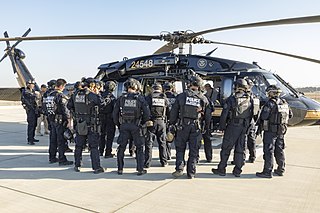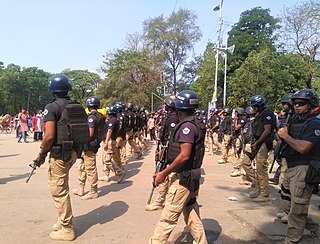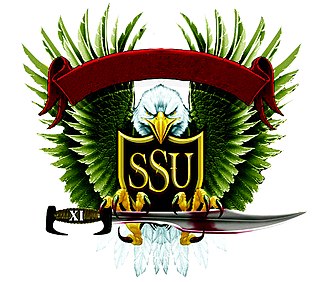
In the United States, a SWAT team is a generic term for a police tactical unit.

The Hostage Rescue Team (HRT) is the Federal Bureau of Investigation's (FBI) elite tactical unit. The HRT was formed to provide a full-time federal law enforcement tactical capability to respond to major terrorist incidents throughout the United States. Today, the HRT performs a number of tactical law enforcement and national security functions in high-risk environments and conditions and has deployed overseas, including with military Joint Special Operations Command units.
The Critical Incident Response Group (CIRG) is a division of the Criminal, Cyber, Response, and Services Branch of the United States Federal Bureau of Investigation. CIRG enables the FBI to rapidly respond to, and effectively manage, special crisis incidents in the United States.

A police tactical unit (PTU) is a specialized police unit trained and equipped to handle situations that are beyond the capabilities of ordinary law enforcement units because of the level of violence involved. A police tactical unit's tasks may include: executing dangerous search warrants and arrest warrants for dangerous persons; arresting or neutralizing dangerous or mentally ill armed persons; and intervening in high risk situations such as shootouts, standoffs, hostage-takings, and terrorist incidents.
In American law enforcement, the Emergency Service Unit, or ESU, is a multi-faceted element within a law enforcement agency’s Special Operations Command.

The Felony Investigative Assistance Team (FIAT) is a multi-jurisdictional police task force comprising 16 law enforcement agencies in Cook County, Illinois, and DuPage County, Illinois. The taskforce covers approximately 300,000 residents in those jurisdictions. It is broken down into five units, four of which are staffed by assigned officers.

Mobile Security Deployments (MSD) is a small specialized tactical unit within the Diplomatic Security Service (DSS) of the United States Department of State. The MSD provides U.S. embassies and consulates with security support, protects the Secretary of State and other U.S. officials, including domestically as well as visiting foreign officials, and also provides security training at U.S embassies and consulates.
Special Operations Response Teams are a group under the US Federal Bureau of Prisons, or BOP for short, a component of the US Department of Justice (DOJ). The BOP is responsible for maintaining the custody of anyone convicted of committing a federal crime. To achieve this goal, the BOP maintains a number of correctional facilities, which are divided into six regions, throughout the US. These facilities house approximately 211,195 inmates of varying security levels. Facilities are designated as either minimum, medium, maximum, or the most recent addition, super max.

Metropolitan Division, commonly referred to as Metro Division or just Metro, is an elite division of the Los Angeles Police Department (LAPD) under its Special Operations Group. Metropolitan Division is responsible for managing the LAPD's specialized crime suppression, K-9, mounted, and SWAT units, named "platoons".

The Emergency Service Unit(ESU) is part of the Special Operations Bureau of the New York City Police Department. The unit provides specialized support and advanced equipment to other NYPD units. Members of ESU are cross-trained in multiple disciplines for police, medical, and rescue work.

The Special Weapons And Tactics(SWAT) (Bengali: বিশেষ অস্ত্র ও কৌশল, সোয়াট) is the police tactical unit of the Dhaka Metropolitan Police of the Bangladesh Police. They operate under Special Action Group of the Counter Terrorism and Transnational Crime. The SWAT was formed to recover illegal arms and arrest hardcore terrorists and has a vital role in neutralizing any and all threats.
The Columbia Police Department (CPD) is the principal law enforcement agency serving the city of Columbia, Missouri in the United States. It protects a metropolitan population of nearly 127,000 with 187 sworn police officers.

The Deployable Specialized Forces (DSF) —formerly Deployable Operations Group— are part of the United States Coast Guard that provide highly equipped, trained and organized deployable specialized forces, to the Coast Guard, United States Department of Homeland Security (DHS), United States Department of Defense (DoD) and inter-agency operational and tactical commanders. The command was formerly headquartered in Arlington, Virginia where it was established on 20 July 2007, and was commanded by a captain. It was decommissioned by the Commandant of the Coast Guard, Admiral Robert Papp on 1 October 2013, with units previously assigned to the DOG being split between Coast Guard Pacific and Atlantic Area commands. The units were subsequently reorganized under Deployable Specialized Forces (DSF).
The Los Gatos/Monte Sereno Police Department serves the cities of Los Gatos and Monte Sereno, located in Santa Clara County, California. The department is made up of 64 sworn officers and regular employees. The department is a full service organization. The department works with several other law enforcement agencies including the California Highway Patrol, Campbell Police Department, San Jose Police Department, and Santa Clara County Sheriff's Office. The cities of Los Gatos and Monte Sereno have very low crime rates, and the citizens directly support the department and its community programs through the Los Gatos/Monte Sereno Police Foundation. The current police chief for the Los Gatos/Monte Sereno police department is Peter Decena.

Tom Clancy's Ghost Recon: Shadow Wars is a turn-based tactics video game for the Nintendo 3DS developed and published by Ubisoft in 2011. The game is part of the Ghost Recon series of the Tom Clancy games. First images of the game were leaked by IGN in 2010. The game was released on March 25, 2011 in Europe, March 27 in North America, and March 31 in Australia as a launch title for Nintendo's new console. It was later released in Japan on May 19, 2011. The game released in North America five days before the Nintendo 3DS North American launch.

The Lenco BearCat is a wheeled SWAT vehicle designed for military and law enforcement use. It is in use by several military forces and law enforcement agencies around the world.
The Pima County Sheriff's Department (PCSD) is an American law enforcement agency that serves the unincorporated areas of Pima County, Arizona. It serves the seventh largest county in the nation. It operates six district offices and three smaller satellite offices. The Corrections Bureau has four facilities which houses on average 1,850 inmates per day.

The militarization of police is the use of military equipment and tactics by law enforcement officers. This includes the use of armored personnel carriers (APCs), assault rifles, submachine guns, flashbang grenades, sniper rifles, and SWAT teams. The militarization of law enforcement is also associated with intelligence agency–style information gathering aimed at the public and political activists and with a more aggressive style of law enforcement. Criminal justice professor Peter Kraska has defined militarization of police as "the process whereby civilian police increasingly draw from, and pattern themselves around, the tenets of militarism and the military model".

The Special Service Unit (SSU) is a component of the California Department of Corrections and Rehabilitation (CDCR). It functions as the special operations division of CDCR. The unit is staffed by special agents[1] assigned to field offices throughout the state. Although the special agents work for CDCR, they are neither correctional officers nor parole agents. SSU special agents are full-time peace officers per California Penal Code Section 830.2. This makes agents more akin to state police officers than to correctional officers.[2]
















